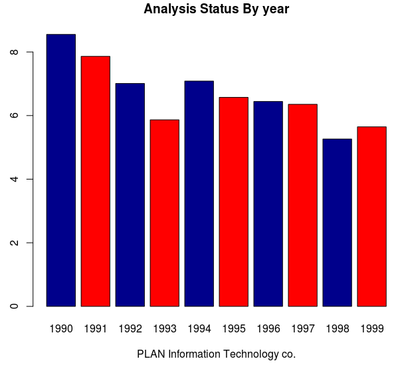통계분석툴 R & MongoDB 연동 방법
안녕하세요? NoSQL 전문가 주종면입니다.
이번 차수에서는 MongoDB를 통계분석 툴인 R을 통해 분석하고 결과를 출력하기위한 연동 방법에 대해 알아보도록 하겠습니다.
먼저, MongoDB를 시작한 후 yield_historical.out 컬렉션에 저장된 데이터를 확인 하겠습니다.
> use mongo_hadoop
switched to dbmongo_hadoop
>
>db.yield_historical.out.find().pretty()
{ "_id" : 1990,"value" : 8.552400000000002 }
{ "_id" : 1991,"value" : 7.8623600000000025 }
{ "_id" : 1992,"value" : 7.008844621513946 }
{ "_id" : 1993,"value" : 5.866279999999999 }
{ "_id" : 1994,"value" : 7.085180722891565 }
{ "_id" : 1995,"value" : 6.573920000000002 }
{ "_id" : 1996,"value" : 6.443531746031742 }
{ "_id" : 1997,"value" : 6.353959999999992 }
{ "_id" : 1998,"value" : 5.262879999999994 }
{ "_id" : 1999,"value" : 5.646135458167332 }
다음은 R을 실행한 후 MongoDB 관련 패키지를 설치한 후 yield_historical.out 컬렉션을 검색해보겠습니다.
$ R
R version 3.0.1(2013-05-16) -- "Good Sport"
Copyright (C) 2013 The RFoundation for Statistical Computing
Platform:x86_64-w64-mingw32/x64 (64-bit)
>
>library("RMongo") ß MongoDB에 접속하기 위한 패키지 로더
> mongo <-mongoDbConnect("mongo_hadoop") ß mongo_hadoop 데이터베이스 접속
> result <-dbGetQuery(mongo, "yield_historical.out", "", 0, 10)
ßyield_historical.out 컬렉션에서 10개의Document 검색
> result ß 결과 검색
X_id value
1 1990 8.552400
2 1991 7.862360
3 1992 7.008845
4 1993 5.866280
5 1994 7.085181
6 1995 6.573920
7 1996 6.443532
8 1997 6.353960
9 1998 5.262880
10 1999 5.646135
// 다음은BARPLOT 함수를 이용하여 막대 그레프 형태의 분석 결과를 확인해 보겠습니다.
> barplot(result$value, main='Analysis Status By year',col=c("darkblue", "red"),names.arg=c("1990","1991", "1992","1993", "1994", "1995", "1996","1997", "1998", "1999"), beside=TRUE,xlab="PLAN Information Technology co.")
다음 문법은 통계분석 툴 R을 통해 MongoDB 내의 컬렉션에 데이터를 조작하는 방법입니다.
// TEST DB에 접속하여 EMPLOYEES컬렉션에 하나의 Document를 입력합니다.
// MongoDB에 접속하여 먼저EMPLOYEES 컬렉션의 상태를 확인한 후 다음 문장을 실행합니다.
test.dbInsertDocument <- function(){
mongo <-mongoDbConnect("test")
output <-dbInsertDocument(mongo, "employees", '{"empno" : 1101,"ename": "Joo JongMyun"}')
dbDisconnect(mongo)
}
test.dbInsertDocument()
mongo <- mongoDbConnect("test")
output <- dbGetQuery(mongo, 'employees', '', 0 , 20)
output
// TEST DB에 접속하여 EMPLOYEES컬렉션에 하나의 Document를 삭제합니다.
test.dbRemoveQuery <- function(){
mongo <-mongoDbConnect("test")
output <-dbRemoveQuery(mongo, "employees", '{"ename": "JooJongMyun"}')
dbDisconnect(mongo)
}
test.dbRemoveQuery()
mongo <- mongoDbConnect("test")
output <- dbGetQuery(mongo, 'employees', '', 0 ,20)
output
// TEST DB에 접속하여 EMPLOYEES컬렉션에 2개의 Document를 입력한 후
"Ju"로 시작되는 이름을 가진 사원을 검색합니다.
test.dbGetQuery <- function(){
mongo <-mongoDbConnect("test")
output <- dbInsertDocument(mongo,"employees", '{"ename": "Ju YoungHyun"}')
output <-dbInsertDocument(mongo, "employees", '{"ename": "JooJongMyun"}')
dbDisconnect(mongo)
}
test.dbGetQuery()
mongo <- mongoDbConnect("test")
output <- dbGetQuery(mongo, 'employees','{"ename": { "$regex": "Joo","$options": "m"} }')
output
// TEST DB에 접속하여 EMPLOYEES컬렉션에서 ename 필드를 기준으로 올림차순으로 분류하여 출력합니다.
mongo <- mongoDbConnect("test")
output <- dbGetQuery(mongo, "employees",'{ "$query": {}, "$orderby": { "ename": 1 } }}')
dbDisconnect(mongo)
output







